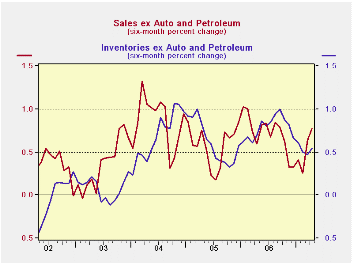 Global| Jun 07 2007
Global| Jun 07 2007U.S. Wholesale Inventories Signal Smoother Sailing
Summary
Wholesale inventory trends tell a very positive story. We take out the volatile and special readings from autos and petroleum to look at aggregated stocks and sales trends for all other wholesale classifications. Once done we obtain [...]

Wholesale inventory trends tell a very positive story. We take out the volatile and special readings from autos and petroleum to look at aggregated stocks and sales trends for all other wholesale classifications. Once done we obtain the chart plotted on the left that shows sales have speeded up as inventories have slowed. They have done that now for the second month in a row on six-month trends. Moreover, it shows that the ramping down in inventories has hit a low and apparent turning point in its decelerating rate of growth, yet another indication that the industry might be through its adjustment phase.
The table below on inventories and sales behavior provides industry detail and time horizon cohorts for that detail. Over three months all main categories, save two, show that sales growth has surpassed inventory growth. The trend of sales (S) outstripping inventories (I) is widespread. Indeed, the two categories that have sales growth above inventory growth are not deficient in their rate of growth by much. Six-month horizons also are very solid. The S>I growth trend seems pretty solid and well-established for now.
Additionally the I/S ratios are in good shape. The overall ratio for all of wholesaling is at a new low dating back to 1998. Durables excluding autos are in their bottom 18 percentile and for nondurables excluding petroleum the ratio is in its bottom 10 percentile.
Conclusion: Overall inventories are in good shape relative to sales. The recent growth rates of inventories relative to sales are settled into a good set of relationships as well. And best of all is the fact that sales growth is on an uptrend. The wholesale report is quite constructive and upbeat.
| I:S ratio | |||||||
|---|---|---|---|---|---|---|---|
| All growth rates annualized | Inventory-&-Sales Trends: Wholesalers | Percent of | |||||
| 2007.Apr | 3-mos | 6-mos | 12-mos | Range | |||
| Sales | Inventories | Sales | Inventories | Sales | Inventories | 1998-date | |
| All Wholesaling | 19.3% | 4.3% | 12.8% | 4.6% | 8.8% | 7.1% | 0.0% |
| Durables | 9.2% | -1.7% | 7.2% | 0.4% | 7.8% | 5.2% | 7.8% |
| Durables less autos | 9.2% | 2.2% | 7.0% | 3.0% | 7.6% | 7.8% | 19.1% |
| Autos | 9.4% | -21.0% | 8.0% | -13.1% | 8.7% | -7.6% | 0.9% |
| Computers | 3.6% | 5.1% | -0.3% | 0.8% | 5.4% | 10.6% | 38.3% |
| Machinery | 3.5% | -2.5% | 8.4% | 2.3% | 5.7% | 7.7% | 33.0% |
| Other Durables | 11.8% | 4.2% | 7.8% | 3.5% | 8.5% | 7.6% | 14.8% |
| Non-durables | 29.9% | 15.7% | 18.6% | 12.4% | 9.7% | 10.4% | 5.2% |
| Non-durables less Petrol | 17.0% | 12.2% | 12.3% | 12.9% | 9.8% | 11.0% | 9.6% |
| Petroleum | 94.5% | 58.5% | 46.4% | 8.2% | 9.3% | 4.7% | 45.2% |
| Groceries | 21.7% | 23.4% | 21.8% | 20.7% | 15.3% | 17.1% | 50.4% |
| Other Non-durables | 15.0% | 9.6% | 8.5% | 11.0% | 7.7% | 9.6% | 11.3% |
Robert Brusca
AuthorMore in Author Profile »Robert A. Brusca is Chief Economist of Fact and Opinion Economics, a consulting firm he founded in Manhattan. He has been an economist on Wall Street for over 25 years. He has visited central banking and large institutional clients in over 30 countries in his career as an economist. Mr. Brusca was a Divisional Research Chief at the Federal Reserve Bank of NY (Chief of the International Financial markets Division), a Fed Watcher at Irving Trust and Chief Economist at Nikko Securities International. He is widely quoted and appears in various media. Mr. Brusca holds an MA and Ph.D. in economics from Michigan State University and a BA in Economics from the University of Michigan. His research pursues his strong interests in non aligned policy economics as well as international economics. FAO Economics’ research targets investors to assist them in making better investment decisions in stocks, bonds and in a variety of international assets. The company does not manage money and has no conflicts in giving economic advice.






